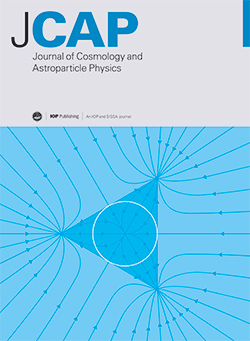Extracting axion string network parameters from simulated CMB birefringence maps using convolutional neural networks
IF 5.3
2区 物理与天体物理
Q1 ASTRONOMY & ASTROPHYSICS
Journal of Cosmology and Astroparticle Physics
Pub Date : 2025-03-04
DOI:10.1088/1475-7516/2025/03/001
引用次数: 0
Abstract
Axion-like particles may form a network of cosmic strings in the Universe today that can rotate the plane of polarization of cosmic microwave background (CMB) photons. Future CMB observations with improved sensitivity might detect this axion-string-induced birefringence effect, thereby revealing an as-yet unseen constituent of the Universe and offering a new probe of particles and forces that are beyond the Standard Model of Elementary Particle Physics. In this work, we explore how spherical convolutional neural networks (SCNNs) may be used to extract information about the axion string network from simulated birefringence maps. We construct a pipeline to simulate the anisotropic birefringence that would arise from an axion string network, and we train SCNNs to estimate three parameters related to the cosmic string length, the cosmic string abundance, and the axion-photon coupling. Our results demonstrate that neural networks are able to extract information from a birefringence map that is inaccessible with two-point statistics alone (i.e., the angular power spectrum). We also assess the impact of noise on the accuracy of our SCNN estimators, demonstrating that noise at the level anticipated for Stage IV (CMB-S4) measurements would significantly bias parameter estimation for SCNNs trained on noiseless simulated data, and necessitate modeling the noise in the training data.利用卷积神经网络从模拟 CMB 双折射图中提取轴弦网络参数
本文章由计算机程序翻译,如有差异,请以英文原文为准。
求助全文
约1分钟内获得全文
求助全文
来源期刊

Journal of Cosmology and Astroparticle Physics
地学天文-天文与天体物理
CiteScore
10.20
自引率
23.40%
发文量
632
审稿时长
1 months
期刊介绍:
Journal of Cosmology and Astroparticle Physics (JCAP) encompasses theoretical, observational and experimental areas as well as computation and simulation. The journal covers the latest developments in the theory of all fundamental interactions and their cosmological implications (e.g. M-theory and cosmology, brane cosmology). JCAP''s coverage also includes topics such as formation, dynamics and clustering of galaxies, pre-galactic star formation, x-ray astronomy, radio astronomy, gravitational lensing, active galactic nuclei, intergalactic and interstellar matter.
 求助内容:
求助内容: 应助结果提醒方式:
应助结果提醒方式:


